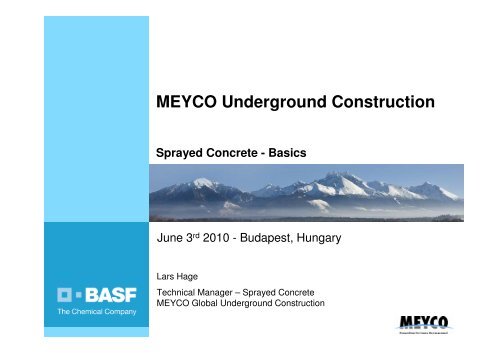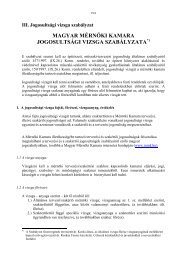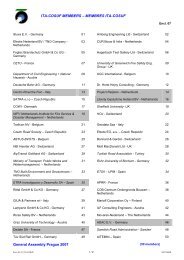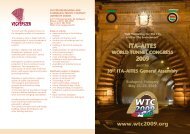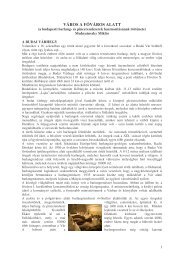meyco sprayed concrete
meyco sprayed concrete
meyco sprayed concrete
You also want an ePaper? Increase the reach of your titles
YUMPU automatically turns print PDFs into web optimized ePapers that Google loves.
MEYCO Underground ConstructionSprayed Concrete - BasicsJune 3 rd 2010 - Budapest, HungaryLars HageTechnical Manager – Sprayed ConcreteMEYCO Global Underground Construction
IntroductionMix design dry-mix versus wet-mixDry-mixWet-mixCement CEM I480 kg/m 3Cement CEM II A-LL450 kg/m 3Sand0/4 mm1’200 kg/m 3Sand0/4 mm1’200 kg/m 3Aggregates4/8 mm600 kg/m 3Aggregates4/8 mm600 kg/m 3Wateradded at the nozzleWater200 kg/m 3Plasticizer6 kg/m 3Retarder2 kg/m 35
IntroductionEN standards for <strong>concrete</strong>EN 197EN 206EN 1008EN 934- 2EN 934- 6CementComposition, specifications and conformity criteriaConcretePerformance, production, placing and compliance criteriaMixing water for <strong>concrete</strong>Admixtures for <strong>concrete</strong>, mortars and groutsPart 2: Concrete admixturesAdmixtures for <strong>concrete</strong>, mortars and groutsPart 6: Sampling, quality control, evaluation ofconformity and marking and labeling6
Factors of influence on the qualityCement CEM I is hard to find while a fewyears ago it it was quite common. CEM II and III are most popularnow but they are not as reactive. The replacement of cement withlimestone, fly ash, silica fumeand slag do not react with setaccelerators and plasticizers. It’s more difficult to achieve therequired high early strengths forthe accelerator and plasticizer.10
Factors of influence on the qualityWater/Cement - Ratio w/c – ratio is critical to: Early setting and strengthdevelopment Long term strength Long term durability –resistance to chemical attack. w/c – ratio should be less then0.50, preferably be around 0.45 The use of high performancesuper plasticizers isrecommended.12
Factors of influence on the qualitySuper Plasticizer GLENIUM ® Low water - cement ratio 0.45 High early and long term <strong>sprayed</strong><strong>concrete</strong> strengths Pump able <strong>concrete</strong> mixes Durability enhancement Low dosage - cost effective13
Factors of influence on the qualityAdmixtures for hydration control Are usually added to <strong>sprayed</strong> <strong>concrete</strong> in order to maintain workabilityand extend the open time during transportation and application withoutreducing <strong>concrete</strong> quality. They can maintain workability, without influencing the hydration, from afew hours to three days depending on dosage rate . To reactivate and neutralize the hydration control effect, a <strong>sprayed</strong><strong>concrete</strong> set accelerator is added during spraying. Hydration control admixtures have no negative influence on theaccelerator dosage. The <strong>concrete</strong> mix can be reactivated at any time with the sameaccelerator dosage rate and with the same setting time, early and finalstrength development14
Factors of influence on the qualityAdmixtures for hydration controlTraditional<strong>sprayed</strong><strong>concrete</strong>MEYCO ® SA acceleratorsaccelerate the processNO CONTROLFlexibility withDELVO ® CRETEStabilisatorManufacturing Delivery Consumption1 – 2 hoursDELVO® CRETE Stabilisatorcontrols hydrationMEYCO ® SA acceleratorsaccelerate the processTAKE BACKCONTROLManufacturing Delivery Intermediate storage Consumption3 – 72 hours15
Factors of influence on the qualityAccelerator Are added to the <strong>concrete</strong> during the spraying to increase the stiffeningrate, to produce a fast ser and get sufficient early strength development. A fast setting <strong>concrete</strong> may be necessary to build up the lining at therequired thickness and to ensure overhead security. Four different types of accelerator are available: Alkali-free accelerators Aluminates Waterglass (Silicates) Modified silicates16
Factors of influence on the qualityAccelerator – pH scale0 4 7 1014ACIDIC NEUTRAL BASICAlkali-freeacceleratorsSafe to human body Modified sodiumsilicate acceleratorsConventionalaccelerators Aluminates: high pH > 12 require particular care including personalprotection against eye burns, skin burns and inhalation. Waterglass: pH > 12, the alkali content (Na 2 O equiv ) between 10 & 18%. Modified silicates: pH < 11.5 and a low Na 2 O equiv < 8.5% Alkali-free: pH value between 2.5 and 8. The maximum Na 2 O equiv of theaccelerator is limited to 1.0% by mass.17
Benefits Alkali-free acceleratorover traditional acceleratorsSilicates Faster setting Faster strength developments Reduced loss of final strength Reduced permeability Better durability Reduced risk for AAR Better working environment andimproved safety (less dust) Environment friendlyAluminates Less sensitive to cements Dramatic reduction in loss offinal strength Better durability Reduced risk for AAR Better working environment andimproved safety Reduced permeability Environment friendly18
Alkali-free acceleratorsHuman and structure friendly Improved working safety – no burns! Less dust and rebound Good short and long term strength Tick layer build rate Improved sulphate resistance when using standard cements Reduction of environmental impact in hardened state CREATES PERMAMENT STRUCTURAL CONCRETE19
Al 2 O 3 /SO 3 based set accelerator mode ofaction: SettingCement Phase Hydration Product Reaction Rate Contribution to Set Contribution to Strength [*]2C 3 S + 7H → C 3 S 2 H 8 + 3CH moderate High High2C 2 S + 7H → C 3 S 2 H 8 + CH slow Low Low initially, high laterC 3 A + 3CŜH 2 + 26H → C 6 AŜ 3 H 32 fast Very High LowC 6 AŜ 3 H 32 + 2C 3 A + 4H → 3C 4 AŜH 12C 4 AF + 2CH + 14H → C 4 (A,F)H 13 + (A,F)H 3 moderate Moderate Low[*] H. F. W. Taylor. Cement Chemistry. London: Academic Press (1997), 113The mechanism by which set accelerators achieve their effect is main fold :• The increased dissolution of the clinker phases by the addition of set accelerators (pH < 3)benefits the quick setting.• The components of these accelerators promote the precipitation of ettringite prisms at a veryearly stage.• A rapid but non usual precipitation of C-S-H around the cement grains which enhances theearly cohesion among the grains and other hydrates occurs. However, it has the strongly drawback toslow down the further dissolution of the anhydrous phases.20
Al 2 O 3 /SO 3 based set accelerator mode ofaction: Strength developmentThe fast setting caused by the addition of the set accelerator is related to a strengthened needon calcium ions in order to form a large amount of hydration products like ettringite, C-S-H…. Ithas been found that in the systems where the [Ca 2+ ] in the pore solution is low the growth of C-S-H is slowed down resulting in a poor strength developmentThe Ca ion concentration at times < 3 h is thekey factor to control the strengthdevelopment in accelerated systems becausethe anisotropic growth rates of C-S-H arecontrolled by the Ca ion concentration.Al 2O 3/SO 3ratio as well as the total amount of Al 2O 3in the setaccelerators influence the [Ca 2+ ] with respect to theprecipitation of secondary gypsum which can redeliver Ca intothe pore solution (in the case of MEYCO ® SA160), and withrespect to the formation of ettringite (in the case of MEYCO ®SA180) which fixes Ca.21
Nozzle techniques have a marked effecton durabilityNozzle angleNozzledistance22
Spraying operationsNozzle system and set up Air and accelerator introduction Air volume Air pressureAir and accelerator hoseConcrete hoseAir hoseAir and accelerator hoseAccelerator hose23
PulsationInterruption in the <strong>concrete</strong> flow/stream Pulsation is mainly caused be either one or a combination of thefollowing two factors: Low workability (low slump) of the <strong>concrete</strong> to be <strong>sprayed</strong>. The design/functionality of the equipment. Some misunderstandings have led people to believe that: A low workability (low slump) <strong>concrete</strong> will require less accelerator Have a positive effect in application of large total layer thickness Is positive for setting, hardening and strength development24
PulsationInterruption in the <strong>concrete</strong> flow/streamThis is not correct for the following reasons: To have an accelerator homogeneously mixed into the <strong>concrete</strong>stream is very important but extremely difficult in a low workability<strong>concrete</strong> (slump < 16 cm). The lower the workability is, the harder it it isto have the accelerator homogeneously distributed into the <strong>concrete</strong>stream. Low workability leads to a reduced filling ratio of the <strong>concrete</strong> cylindersof the <strong>concrete</strong> pump. This creates pulsation in the <strong>concrete</strong> stream. Standard <strong>concrete</strong> pumps are designed to pump conventional <strong>concrete</strong>.Generally they give significantly higher pulsation than pumps designedspecifically for Sprayed Concrete. Low workability <strong>concrete</strong> dramaticallyreinforces this effect.25
PulsationInterruption in the <strong>concrete</strong> flow/streamLow workabilityAcceleratorConcreteConcrete output versus accelerator dosageHigh workabilityAcceleratorConcrete26
PulsationInterruption in the <strong>concrete</strong> flow/streamPulsation will result in Sagging and slip off/drop outs of<strong>concrete</strong> during application. Layering effect in the applied<strong>sprayed</strong> <strong>concrete</strong>. Reduced durability due to thenegative effect of the SprayedConcrete from over-dosage ofaccelerator. Reduced strength and safety,due to the entire thickness notacting as one uniform layer.Layering27
Parameter effecting mixing andperformance of accelerator Slump below 15cm is hard to pump Poor mixing efficiency of accelerator into stiff material Overdosing of accelerator due to poor piston filling efficiency High pulsation – layering effectSlump 18 to 20 cmSpread 50 to 55 cm Viscosity of accelerator The accelerator at the right temperature helps. Therefore theaccelerator can heated a little but not boiled.28
Sprayed <strong>concrete</strong>Early strength development The terminology, early strength is mostlyused for the strength developed from timeof application until the first hour is reached. This early strength is critical for theapplication, in terms of being able to builda Sprayed Concrete layer without saggingand drop outs 3 & 6 minutes. But, there is a link between very earlystrength and strength development. Too high early strength very often results ina lower strength development.29
Sprayed <strong>concrete</strong>Early strength development The early strength is most essential as mentioned for the application Safe application without drop outs at an effective speed of application tothe required thickness must be ensured Temperature of <strong>concrete</strong>, ambient temperature as well as thetemperature of the strata, and the applied thickness is a very importantfactor for initial and final set, as well as further strength development30
Sprayed <strong>concrete</strong>Strength developmentSpecial casesExcavationprotectionSlopes10 100 100031
Sprayed <strong>concrete</strong>Strength development Continue with strengthmeasurement HiltiEquipment32
AcceleratorSetting and strength development The accelerators initially act as aslump killer, and immediatelyreduce the workability of theSprayed Concrete to a zeroslump. The <strong>sprayed</strong> <strong>concrete</strong> is still in aplastic state at the time it itreaches the substrate.33
Sprayed <strong>concrete</strong>Mid term strength & final strength Mid term strength is mostly meant for the 7 days, but often civil projectscan have a requirement for 3 days strength. Final strength is mostly used for 28 days strength. But with some of the alkali-free accelerators, one can see a continuousstrength development also after 28 days, in comparison to a decrease instrength over time, as has been the fact with traditional accelerators likeSilicate and Aluminate based accelerators.34
Sprayed <strong>concrete</strong>Summary W/C ratio to be controlled No retarding admixtures Good workability of the <strong>concrete</strong> to ensure a homogeneous mix of theaccelerator into the <strong>concrete</strong> stream Minimize pulsation with choose of correct engineered equipment, andgood workable <strong>concrete</strong> that allow for a high filling ratio Initial and final set to be balanced Temperatures and applied thicknesses influence strength development Control of strength development Curing conditions/after treatment of the <strong>concrete</strong> is essential for strengthdevelopment and durability35


